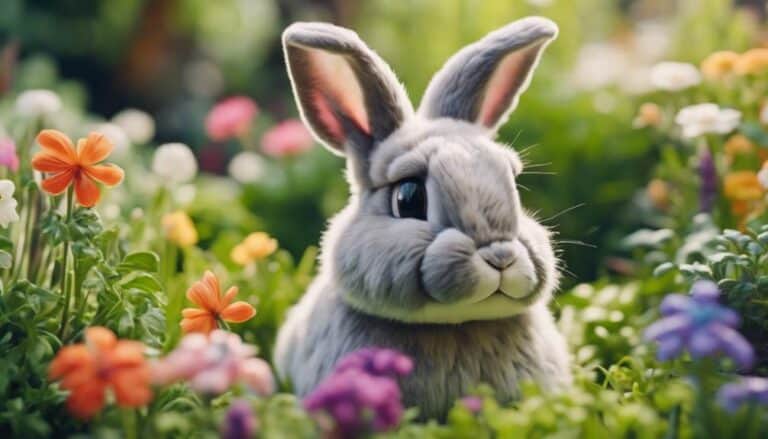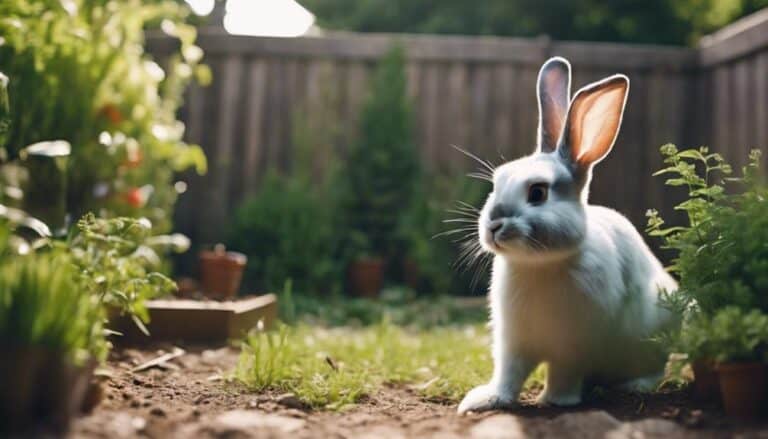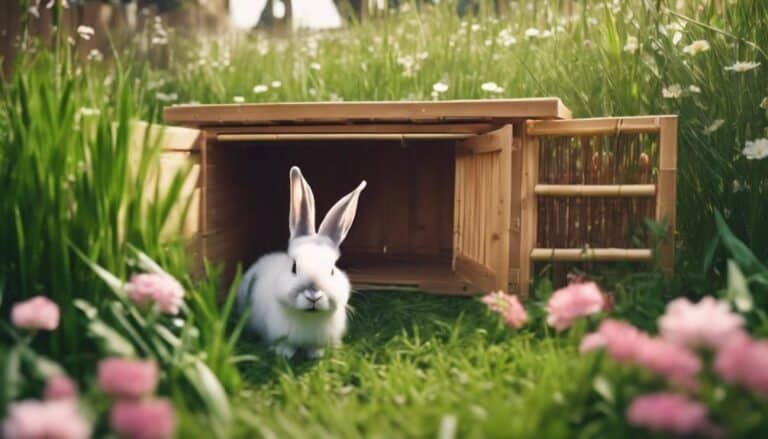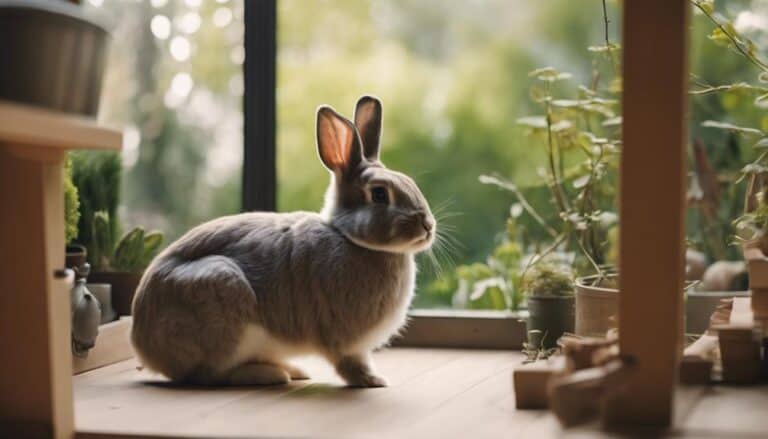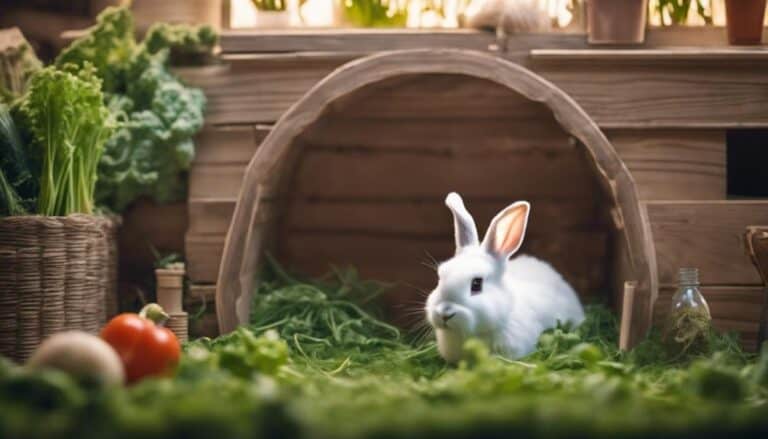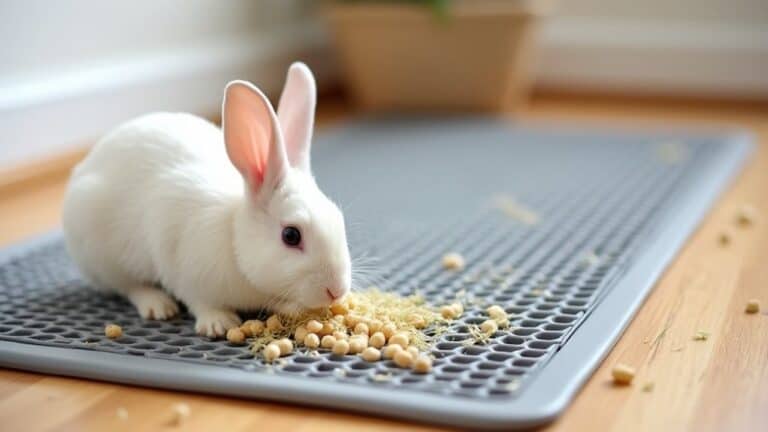Imagine walking into a serene oasis where fluffy companions hop about, each with a space tailored to their comfort and safety. As a beginner in the art of designing bunny habitats, you may find yourself overwhelmed by the myriad of choices and considerations.
But fear not, for within these pages lies a wealth of guidance to steer you towards creating a haven that will not only meet but exceed your furry friend's needs. It all begins with understanding the essentials of bunny habitat design and the essential elements that contribute to a joyful and thriving bunny environment.
Contents
- 1 Key Takeaways
- 2 Bunny Habitat Essentials
- 3 Choosing the Right Enclosure
- 4 Providing Proper Bedding and Litter
- 5 Ensuring Access to Hay and Water
- 6 Creating Enriching Play Areas
- 7 Setting Up Feeding Stations
- 8 Incorporating Safe Hiding Spots
- 9 Monitoring and Maintaining Habitat Health
- 10 Frequently Asked Questions
- 11 How Can I Design a Habitat for My American Bunny Based on the Care Guide?
- 12 Conclusion
Key Takeaways
- Provide soft resting areas and multiple litter boxes for comfort and hygiene.
- Choose a spacious enclosure with appropriate flooring and hiding spots for security.
- Use paper-based litter, hay, and safe bedding materials for cleanliness and comfort.
- Monitor rabbit health, maintain cleanliness, and encourage natural behaviors for overall well-being.
Bunny Habitat Essentials
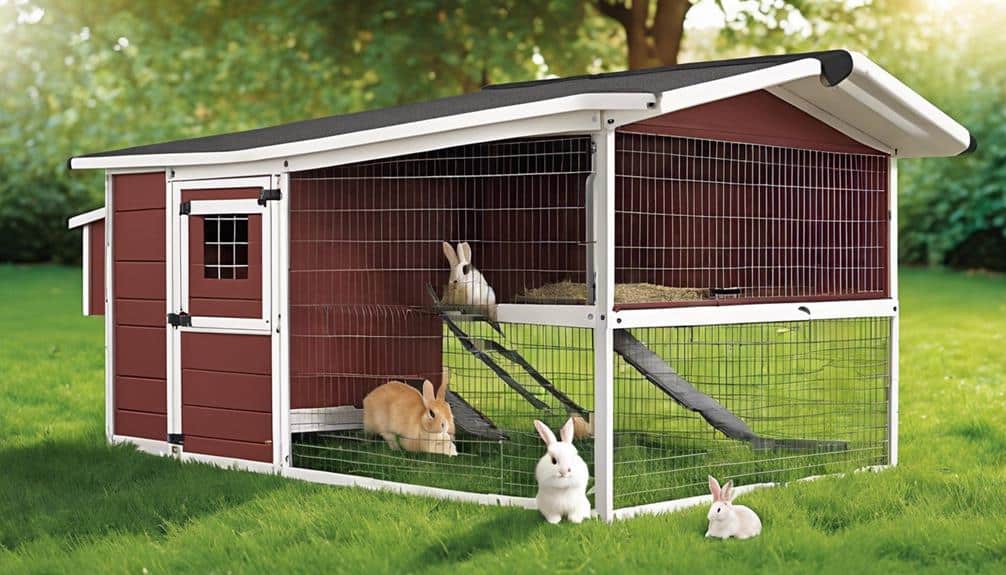
In designing a bunny habitat, ensuring soft resting areas are available is vital for providing comfort and preventing foot sores. Rabbits, like any pet, need a cozy spot to relax and unwind. Plush bedding or blankets can serve as comfortable resting places for your furry friend. Additionally, having multiple litter box areas in the habitat is necessary for encouraging proper bathroom habits and maintaining cleanliness. Rabbits are naturally clean animals, and a tidy environment is essential for their well-being.
Enrichment toys play a significant role in keeping your rabbit mentally stimulated and preventing boredom. These toys can include chew toys, tunnels, or puzzle feeders to engage your pet and keep them active and happy. Providing a safe and secure environment with appropriate flooring is essential for a happy and healthy rabbit habitat. Ensure there are hiding spots or shelters where your rabbit can retreat to feel secure. By incorporating these elements into your bunny's habitat, you're creating a space where your pet can thrive and be content.
Choosing the Right Enclosure
When selecting the appropriate enclosure for your rabbit, prioritize dimensions of at least 4ft by 2ft or 8 square feet to guarantee ample space for comfort and mobility. To confirm your bunny's habitat meets their needs, consider the following tips:
- Opt for a pet exercise pen instead of traditional cages to provide more space for your rabbit to move around freely.
- Use a cat litter box with paper-based litter to confirm cleanliness and avoid potential health issues associated with clay-based options.
- Allow ample space within the enclosure for your rabbit to hop around and exercise, promoting their physical and mental well-being.
- Include a hiding house where your rabbit can retreat to feel safe and secure, mimicking their natural behavior in the wild.
Providing Proper Bedding and Litter
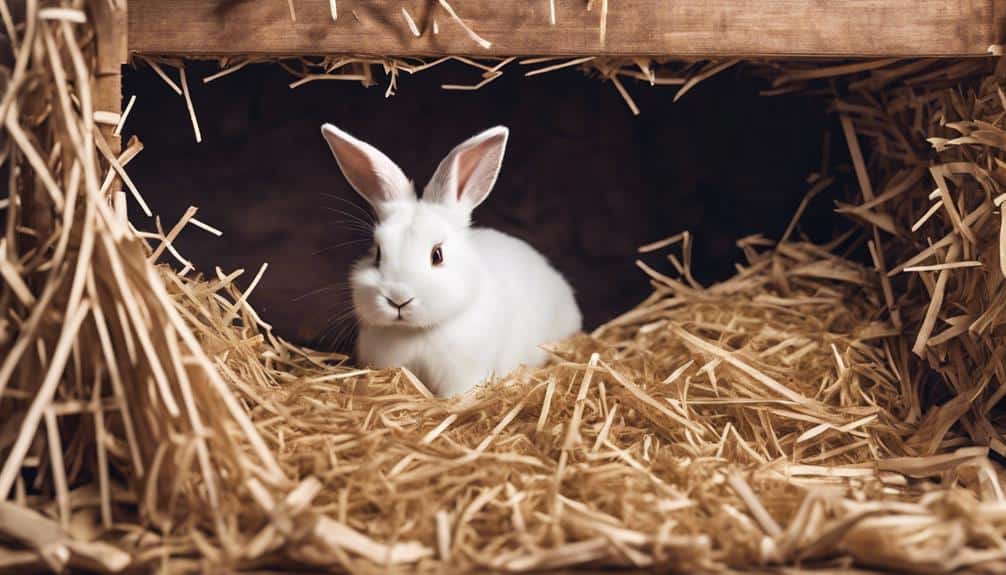
When setting up your rabbit's habitat, choose paper-based litter for safety and cleanliness.
Always have hay available near the litter box for digestion and dental health.
Opt for high-sided boxes and soft flooring to keep your rabbit comfortable and clean.
Bedding Types
Consider using paper-based litter for your bunny's habitat to promote their health and well-being while preventing potential issues associated with clay-based options. When choosing bedding for your rabbit, opt for soft and absorbent materials like towels, mats, or soft bath mats.
Here are some key points to keep in mind:
- Choose paper-based litter: Opt for paper-based litter over clay-based options to guarantee health issues prevention.
- Provide a litter box: Fill it with paper-based litter to absorb moisture and control odor.
- Avoid traditional bedding: Stay away from materials that can be harmful if ingested by rabbits.
- Use soft, absorbent bedding: Guarantee your rabbit's comfort and traction with soft bedding options.
Litter Box Setup
To provide your rabbit with a comfortable and hygienic environment, make sure that the litter box is equipped with high-sided walls for containment and lined with paper-based bedding or hay for absorption and odor control. High-sided litter boxes help prevent messes and offer your rabbit a sense of privacy. Avoid using clay-based litter as it can be harmful if ingested.
Place the litter box in a quiet corner where your rabbit feels safe and comfortable. Regularly changing the bedding in the litter box is essential to maintain cleanliness and hygiene for your rabbit. By following these steps, you're ensuring that your rabbit has a clean and cozy space to take care of their business.
Ensuring Access to Hay and Water
Guarantee your rabbit has easy access to fresh hay and water throughout the day by strategically placing hay racks and water bowls in convenient locations within their habitat. Here's how you can guarantee your furry friend stays healthy and happy:
- Provide hay for dietary needs: Hay is essential for your rabbit's digestion and dental health, so make sure it's always available.
- Encourage foraging behavior: By placing hay near the litter box, you can stimulate your rabbit's natural foraging instincts and keep them engaged.
- Hydration is key: Place water bowls away from the litter box to guarantee your rabbit stays hydrated throughout the day.
- Fresh water is a must: Remember to change the water daily to maintain cleanliness and freshness for your rabbit's well-being.
Creating Enriching Play Areas

To create an engaging environment for your bunny, it's important to design play areas that cater to their natural behaviors and provide mental and physical stimulation. Rabbits are curious and active animals, so offering a variety of toys is essential. Incorporate tunnels for them to explore and cardboard boxes for hiding and playing. Chew toys are vital to satisfy their natural urge to gnaw and keep their teeth healthy. Remember to rotate toys regularly to prevent boredom and keep the environment enriching.
Including interactive toys like treat balls or puzzle feeders can stimulate your rabbits' minds and provide entertainment. Additionally, providing hiding spots and platforms in their play areas allows rabbits to feel secure while exploring. By offering a mix of toys that encourage both mental stimulation and physical exercise, you can create a dynamic and engaging play area that will keep your bunnies happy and healthy.
Setting Up Feeding Stations
When setting up feeding stations for your bunny, it's important to contemplate the types and amounts of food they need for a balanced diet. You should also establish a feeding schedule that aligns with your rabbit's natural eating patterns.
Make sure that the food and water bowls are easily accessible and placed away from their litter box area to prevent contamination.
Food Types and Amounts
Setting up feeding stations involves strategically placing fresh Timothy hay, high-quality pellets, and a variety of fresh vegetables to guarantee a well-rounded diet for your rabbit. When setting up your bunny's feeding area, make sure the following:
- Timothy Hay: Provide fresh Timothy hay in a hay rack near the litter box at all times.
- High-Quality Pellets: Offer pellets without added colorful pieces to prevent selective eating and ensure proper nutrition.
- Fresh Vegetables: Include a variety of fresh vegetables daily to supplement hay and pellets for a well-rounded diet.
- Water: Make sure water is available in a heavy bowl at all times to prevent tipping and keep your rabbit hydrated.
Feeding Schedule Tips
Strategically distributing feeding stations throughout your bunny's habitat can promote movement and discourage resource guarding.
Guarantee each station includes fresh hay, water, and pellets in separate bowls to provide easy access to essential nutrients.
Keep feeding areas away from the litter box to uphold hygiene standards and prevent contamination.
Monitor your rabbit's eating habits closely and adjust the feeding schedule accordingly to meet their individual needs.
Regularly rotate and clean feeding bowls to prevent bacterial buildup and maintain a healthy feeding environment.
Location and Accessibility
To guarantee your bunny's feeding stations are ideally situated, focus on placing them in easily accessible areas within their habitat while keeping them away from the litter box to maintain cleanliness. Here are some tips to help you set up feeding stations effectively:
- Positioning: Place feeding stations in quiet spots to prevent stress during meal times.
- Multiple Stations: Provide multiple feeding stations in different areas to encourage movement and foraging behavior.
- Ceramic Bowls: Consider using heavy ceramic bowls to guarantee stability during feeding.
- Location: Make sure food and water bowls are located away from the litter box to maintain cleanliness.
Incorporating Safe Hiding Spots
When designing bunny habitats, incorporating safe hiding spots is essential to make sure the rabbits feel secure and comfortable in their environment. Rabbits need these hiding spots to reduce stress and mimic their natural behavior of seeking shelter in the wild.
You can provide hiding spots in the form of tunnels, boxes, or enclosed areas within the enclosure. Having multiple hiding spots allows rabbits to choose where they feel most comfortable, promoting their well-being. Make sure these hiding spots are easily accessible and spacious enough for the rabbit to move around comfortably.
Monitoring and Maintaining Habitat Health
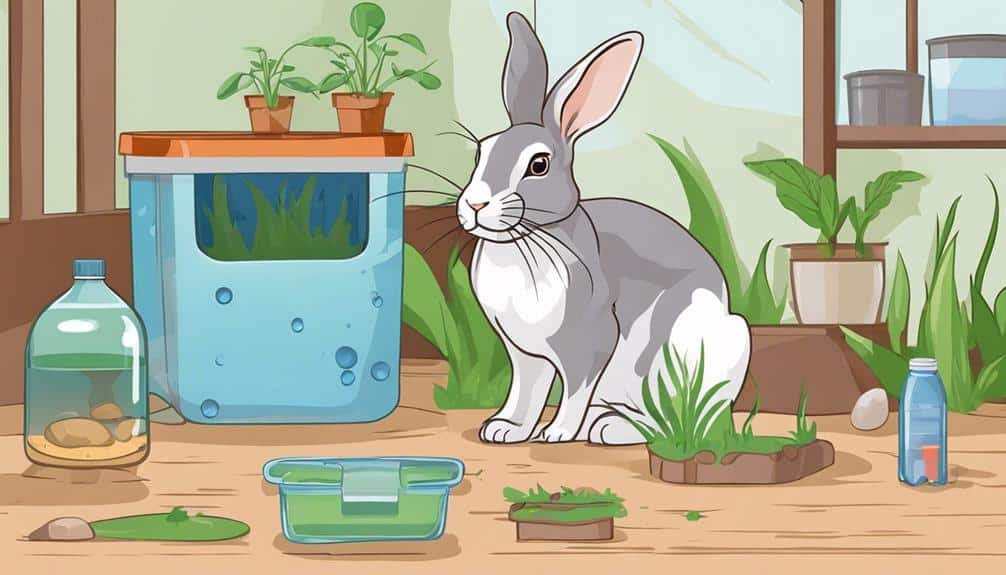
Regularly conducting health checks is crucial for monitoring and maintaining the well-being of your rabbit and addressing any issues promptly. To make certain your rabbit's habitat remains a healthy environment, here are some essential tips to follow:
- Conduct weekly health checks to monitor any changes in your rabbit's well-being.
- Keep the habitat clean and hygienic by regularly cleaning and removing soiled bedding.
- Monitor food and water levels daily to guarantee your rabbit's nutritional needs are met.
- Watch for any signs of stress or behavioral changes in your rabbit, as these could indicate potential health concerns.
Frequently Asked Questions
How Do You Create a Rabbit Habitat?
For a indoor rabbit habitat, pick a spacious enclosure, provide a litter box, hay, food, and water bowls, a hiding house, toys, soft flooring, and supervise for territorial issues. Assure a safe and enriching environment.
What Is the Best Setup for a Rabbit Enclosure?
For a high-quality rabbit enclosure, choose a large pet exercise pen. Confirm soft flooring for comfort, consider lighting needs, and enrich your bunny's life with toys. Whether indoor or outdoor, prioritize ventilation for a healthy habitat.
How Do You Set up a Bunny Area?
To set up a bunny area, choose safe flooring like linoleum, bunny-proof wires, set feeding stations with hay nearby, add enrichment activities like toys, provide hiding spots, and use natural light sources for their well-being.
What Are the Measurements for a Rabbit House Design?
If you're planning a rabbit house, dimensions should be at least 4ft by 2ft, providing 8 square feet of space. Remember to take into account material selection, ventilation, lighting, and safety. Your fluffy friend deserves a cozy abode.
How Can I Design a Habitat for My American Bunny Based on the Care Guide?
When designing a habitat for your American bunny, follow the American Bunny Care Complete guide. Ensure the enclosure is spacious, with a solid bottom, and provide a hiding spot. Offer a balanced diet of hay, veggies, and pellets. Regularly clean the habitat and provide mental stimulation to keep your bunny happy.
Conclusion
To sum up, designing a bunny habitat is like creating a cozy retreat for your furry friend. By incorporating essential supplies, providing ample space, and catering to their natural behaviors, you can guarantee a happy and healthy living environment for your bunny.
Remember to monitor and maintain their habitat regularly to keep them safe and comfortable. With a little love and attention to detail, you can create a bunny paradise that your fluffy companion will truly appreciate.

